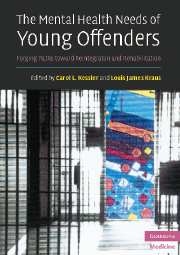Book contents
- Frontmatter
- Contents
- List of contributors
- Foreword
- Acknowledgments
- 1 An overview of child and adolescent mental health needs in the juvenile justice system
- 2 Psychiatric disorders of youth in detention
- 3 Disproportionate minority confinement
- 4 Police interrogation of youth
- 5 Assessing children's competence to stand trial and to waive Miranda rights: new directions for legal and medical decision-making in juvenile courts
- 6 The etiology of antisocial behavior: biopsychosocial risk factors across development
- 7 Substance abuse in youth offenders
- 8 Suicide and delinquent adolescents
- 9 Juvenile sex offenders
- 10 Educational needs of youth in the juvenile justice system
- 11 Science and the juvenile death penalty
- 12 Medical issues regarding incarcerated adolescents
- 13 Mental health screening and assessment in juvenile justice
- 14 Psychological testing in juvenile justice settings
- 15 Psychopharmacology and juvenile delinquency
- 16 Evidence-based treatment for justice-involved youth
- 17 Community alternatives to incarceration
- 18 Innovative problem-solving court models for justice-involved youth
- 19 Ethical issues of youthful offenders: confidentiality; right to receive and to refuse treatment; seclusion and restraint
- 20 Post-adjudicatory assessment of youth
- Index
- References
20 - Post-adjudicatory assessment of youth
Published online by Cambridge University Press: 11 August 2009
- Frontmatter
- Contents
- List of contributors
- Foreword
- Acknowledgments
- 1 An overview of child and adolescent mental health needs in the juvenile justice system
- 2 Psychiatric disorders of youth in detention
- 3 Disproportionate minority confinement
- 4 Police interrogation of youth
- 5 Assessing children's competence to stand trial and to waive Miranda rights: new directions for legal and medical decision-making in juvenile courts
- 6 The etiology of antisocial behavior: biopsychosocial risk factors across development
- 7 Substance abuse in youth offenders
- 8 Suicide and delinquent adolescents
- 9 Juvenile sex offenders
- 10 Educational needs of youth in the juvenile justice system
- 11 Science and the juvenile death penalty
- 12 Medical issues regarding incarcerated adolescents
- 13 Mental health screening and assessment in juvenile justice
- 14 Psychological testing in juvenile justice settings
- 15 Psychopharmacology and juvenile delinquency
- 16 Evidence-based treatment for justice-involved youth
- 17 Community alternatives to incarceration
- 18 Innovative problem-solving court models for justice-involved youth
- 19 Ethical issues of youthful offenders: confidentiality; right to receive and to refuse treatment; seclusion and restraint
- 20 Post-adjudicatory assessment of youth
- Index
- References
Summary
Introduction
The first juvenile court in the United States was established in Chicago in 1899. With the realization that children had specific developmental needs different from adults, and in association with a rehabilitative as opposed to punitive focus, juvenile courts developed a parens patriae model. As time progressed, it became evident that such a model needed to be balanced with police power, that is, protecting the constituents of one's state. During this process there were a variety of developments within the juvenile court system. Many of these are not in the best interests of the child; do not take into account developmental and mental health needs; and do not use mental health services in assessing these issues. Examples of these issues include court-by-court variation in determining juvenile competency to stand trial or understand Miranda rights, transfer of youth to adult systems, and mandatory waiver to adult court. With regard to the latter, Grisso (1997) reports on evidence that youths' immaturity creates a substantial risk that they cannot approach their trials in adult court with the requisite understanding and decision-making capacities to assure a fair legal process.
At the present time, there is concern over a shift from juvenile court having a more rehabilitative model to the criminalization of juvenile court (Quinn, 2002). Intensified youth violence and a decrease in public support for youth offenders have contributed to a more punitive concept, certainly from a public perspective. However, jurisdictions are variable, with some juvenile courts continuing to focus heavily on rehabilitation.
- Type
- Chapter
- Information
- The Mental Health Needs of Young OffendersForging Paths toward Reintegration and Rehabilitation, pp. 423 - 436Publisher: Cambridge University PressPrint publication year: 2007



